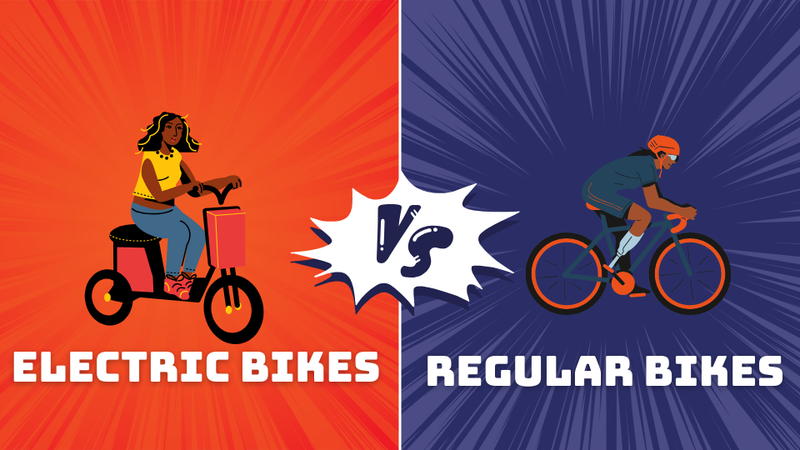Are You an E-Bike Rider or a Casual Cyclist? Deciding between an Electric Bike (e-bike) and a Regular bike can be overwhelming.
Both solutions may offer unique benefits and drawbacks; which would make the best fit?
Let's break down what each type offers, so you can make the best pick without breaking a sweat (unless you want to).
How Do Electric Bikes Work?
Have you experienced a sudden burst of speed while riding a bicycle that seemed too effortless? Chances are it was likely an electric bicycle (e-bike).
Here's the thing: E-bikes come equipped with a motor, battery, and a comprehensive control system.
These parts work together to give you that extra push when needed most, whether that means steep hills or long commutes.
Think of it like having a secret weapon on tap.
- Pedal-assist mode helps boost your pedaling power based on your effort.
- More push on the pedals, more help from the motor – perfect for getting up that hill with a smile.
- Throttle mode is there when you just need a break and want to cruise without pedaling.
- This mode is ideal for a relaxed ride or quick bursts of speed.
But let’s not forget – e-bikes need charging, and overuse of the assist modes can drain the battery faster than you’d like.

Similarities Between Electric and Regular Bikes
E-bikes and traditional bikes share the core principles of cycling: freedom, fresh air, and an element of adventure.
They feature similar frames, wheels, pedals, and maintenance requirements - such as tire pressure checks and chain lubrication - making maintenance simple.
Both types can bring you there, whether cycling to work or hitting the trails.
Key Differences Between Electric and Regular Bikes
What exactly is the difference? Let's investigate this closely:
Speed and Range
With an e-bike, speeds of 20mph (or even 28mph for specific models) can easily be attained.
Do you feel like having the wind at your back without all the unexpectedness?
Regular bikes rely on leg power instead of pedal power; their pace will likely be more modest unless you aspire to become the next Tour de France participant.
E-bikes typically boast a battery range between 20-60 miles, depending on terrain and environment.
An average bike has no set limit for its "range." Instead, its performance depends entirely on your strength.
The Ride Itself
E-bikes provide variable levels of assistance, making them the perfect solution for people wanting to ride longer without running out of breath.
On a bike, every hill and headwind represents your fitness challenge.
You may sweat more when undertaking an intense workout session - that is precisely the point!
Weight and Portability
This one's obvious: electric bikes tend to weigh more.
That motor and battery combine for some serious extra weight.
Investing in a regular bike will simplify life if you must transport your ebike upstairs or onto public transportation.
Modern e-bikes have made great strides forward in terms of ease of use with removable batteries, yet they still pose more of a burden than their non-electric siblings.
Read more: Choosing the Right Bike Frame Type
Pros and Cons of E-Bikes
| Aspect | E-Bikes | Regular Bikes |
|---|---|---|
| Pros | - Effortless commutes and longer rides | - Lighter and easier to store or transport |
| - Accessible for various fitness levels | - Cheaper to buy and maintain | |
| - Customizable assistance for adjustable workout intensity | - Ideal for full-body workouts, boosting endurance and cardio | |
| Cons | - Higher initial cost and maintenance expenses | - Requires significant physical effort, especially on long or uphill rides |
| - Battery life needs regular management; charging required | - Limited speed and distance without assistance | |
| - Heavier and less portable |
Environmental Impact
They are physically taxing on long or hilly rides. Without assistance, speed and distance limitations apply. Greener alternatives than cars exist, with regular bikes being the greenest of the bunch.
Why? They lack batteries and motors, which consume energy and materials, and manufacturing processes consume both.
E-bikes powered by renewable energy sources still contribute to reducing car emissions, particularly when riding through urban environments.
Health and Fitness Benefits
The health and fitness benefits of exercise are considerable.
Traditional bikes remain an indispensable means of reaching fitness objectives.
Maximum cardio, muscle engagement, and caloric burn.
But wait to rule out electric bikes.
Studies reveal that people ride them more frequently and for greater distances.
So, the cumulative health benefits can still accrue without exerting as much sweat equity.
Safety Considerations
While faster speeds may increase the chance of accidents, studies show that e-bike accidents are comparable with traditional bicycles in accident rates.
Managing that power can be tricky, so learning to harness its full potential is the key.
Use protective equipment like helmets, whether it's an e-bike or a classic bike.

Conclusion
Deciding between an electric bike or a traditional bicycle ultimately depends on your personal goals.
For an affordable yet vigorous workout, nothing beats traditional bikes.
But if you prefer longer and smoother rides without the effort required, an e-bike could become your go-to solution.
Simply stated, the ideal bike is one that gets you out and about, enjoying nature and feeling its wind in your hair.
Select your bike, start pedaling, and enjoy the journey - regardless of its motorization status.
FAQs
What are the main differences between e-bikes and regular bikes?
E-bikes have motor assistance, making them faster and better for long rides, while regular bikes are lighter and require full physical effort.
Are e-bikes more expensive than regular bikes?
Yes, e-bikes generally have higher upfront and maintenance costs due to their electric components.
Can e-bikes still provide a workout?
Yes, e-bikes can still offer a workout, especially in lower assistance modes where the rider pedals more.


















